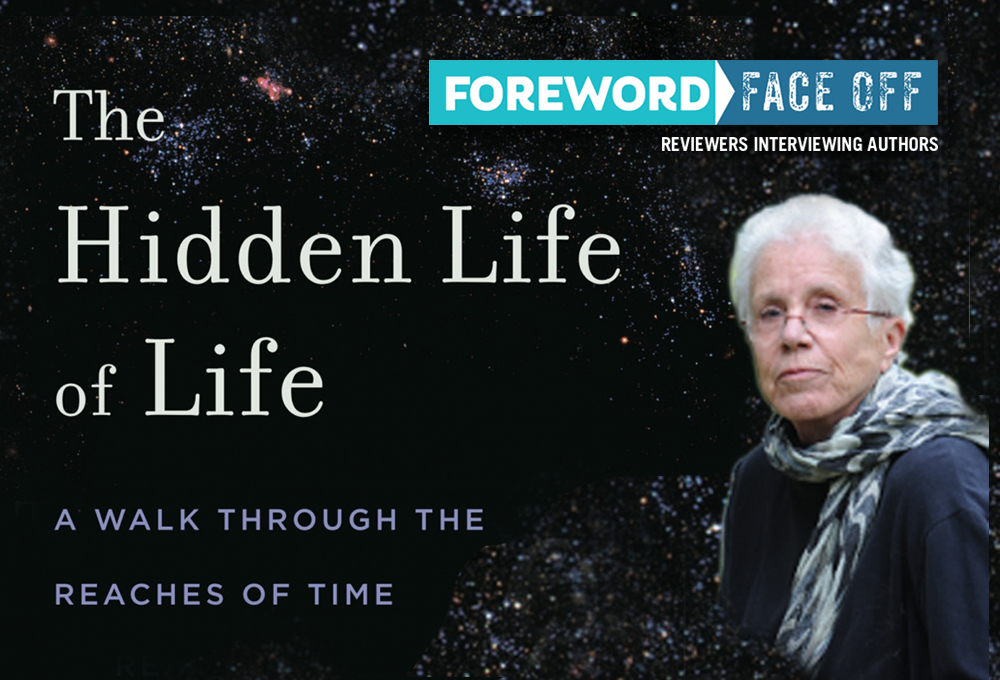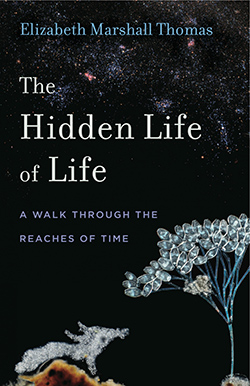Interview with the Author of The Hidden Life of Life

Editor-in-Chief Matt Sutherland Interviews Elizabeth Marshall Thomas, Author of The Hidden Life of Life

Necessarily, reviewers and savvy readers of nonfiction hone an ability to quickly take measure of a book to decide whether it deserves to be read—usually by scanning back cover copy, testimonials from other authors, the TOC, introduction, and perhaps the first few pages of chapter 1. Alas, sometimes, all that effort is to no avail—as was my experience with The Hidden Life of Life. And then I read Elizabeth Marshall’s bio, which explained everything. With thirteen books to her credit, peerless writing chops, an incredibly broad knowledge base, and a lifetime of careful thought, she is one of the very few people on earth who could have written this book.
Susan Waggoner reviewed the book in our May/June issue of Foreword Reviews, and it was my great honor to recently ask Elizabeth a few burning questions—one of which led to her theory about sexy Neanderthals. I kid you not. Check out the Special Features and Featured Reviews further below.
Can you talk about how you conceptualized The Hidden Life of Life, the challenges in writing such a sprawling, big-thinking project, and whether you’re pleased with the accomplishment (and it is an accomplishment)?
I think I conceptualized The Hidden Life of Life as a part-way exposure of and answer to anthropodenial, the name Franz de Waal has given to our ignorance of other life forms when we say they don’t have human characteristics. But I can’t say I considered this a challenge because to me it’s all so interesting, and the book was so much fun to write. I’m not sure I’m completely pleased with it, though—for one thing, something became known AFTER the book was in press—in the book I say that humans are the only species to use fire, only to learn that in Australia (I think it was Australia) certain hawks take branches from wildfires and fly away with them to use them to ignite fires elsewhere so they can catch and eat the little creatures who run out. That’s something like what Homo erectus did, but he did it to start his own fire at his encampment. And the hawks are certainly “using” fire.
Early in the book, you outline Gaia’s rules for life: (1) find a source of energy, (2) protect yourself from the elements and predators, and (3) create offspring. More or less, the rules have been observed for four billion years or so. But the billion dollar question remains: where did it all start? Why is that such a difficult question to answer? Do you think we’ll ever know conclusively? Care to mention which theory you like best?
I think Gaia’s rules must have started pretty early on. Some bacteria make their own food—those that photosynthesize—but others absorb nutrients from other organisms. As for Rule Two, I’d say they protect themselves by being so small, but that probably doesn’t count, so maybe Rule Two came later. But they keep Rule Three by splitting in half. Where there was one bacterium, there now are two bacteria. That’s reproduction. All this would suggest that Gaia’s rules began with very early life. And actually, these three rules more or less define life.
You describe uncanny connections and similarities between microbes, fungi, bacteria, yeasts, right on up the evolutionary ladder to the way we as humans behave as organisms. I was struck when you mentioned that the mitochondria in our cells may have been “independent organisms once—they’re different from our body cells in that their genes are like those of bacteria rather than like ours.” That idea really brought home the realization that evolution isn’t just happening amongst species, it’s happening at all levels of life. Will you explain some of the differences between how evolution is playing out now, as opposed to a million or billion or three billion years ago?
This is a tough question. To the best of my knowledge, evolution means the furthering of useful characteristics, and this must have started with microbes, or even with proto-life virus-type organisms that seem to have given rise to microbes. Those without the useful characteristics didn’t do as well or reproduce as successfully as those who had them. Throughout the course of evolution, symbiosis has been helpful. If two organisms, each successful on its own, joined together, a really successful organism could result, and perhaps would live longer or reproduce better than organisms who were doing it on their own. Consider lichens, for instance. A lichen is two life-forms in one body. But maybe a lichen isn’t considered a fabulously successful organism—in which case our mitochondrial cells are better.
Throughout the book, you poke holes at the idea that humans have super-advanced abilities compared to other life forms that inhabit the planet. You point to the sporozoite parasite and the four different forms it takes when moving from a mosquito’s gut to a human’s liver to human red blood cells to a ball-shaped structure as it seeks to move onto a different place or victim. Another equally impressive creature is the Cordyceps fungi that controls the brains of ants to perform extraordinary feats. All of which is astounding, not least because certain scientists had the good sense and patience to document these behaviors. With technology at our fingertips, do you see science as entering a golden age?
Gosh. I think science has been in a golden age for quite a while. But yes, it’s getting more golden these days, as the scientists are finally acknowledging that non-humans have mental powers that match or exceed our own. Anthropomorphism is no longer a scientific sin, although the scientists wouldn’t put it that way. It’s also been acknowledged that you don’t need a brain to achieve your goals, and certainly not a big brain. Some fish learn faster than we do. How the big-brain idea ever got started is beyond me—at least some of the scientists who held this notion had dogs, and the brain of a Great Dane is bigger than the brain of a Chihuahua although both are equally smart. I shouldn’t really be judging about things like this, though. I bet lots of work was done on this subject, and I haven’t seen that work.
Neanderthals are enjoying some newfound prestige as we better understand just how intelligent, artistic, sophisticated, and physically-impressive they really were. And yet they couldn’t seem to hack it evolutionarily. Will you take a moment to sing their praises to some of our more skeptical readers?
As for Neandertals, did they really go extinct? Or did they merge with us. Lots of them merged, I’m sure of that, and I hate to think that our species played any other role, even though we’re now making everything else go extinct. I just don’t think that the early Homo sapiens could wipe out people as strong and successful as the Neandertals, so I’m going with Darwin’s theory, that women are drawn to big bearded men, and sexual selection determined the consequences. We Homo sapiens women liked the Neandertal men better than we liked our own men, and most or all of the resulting children carried Homo sapiens mitochondria. But who am I to have a theory on something as major as that?
Lastly, can I ask what’s on your reading list of late? What in the universe has your interest now and will it lead to another book project?
Gosh again. I don’t really have a current reading list because I don’t have time to read anything. I’m working on a book about aging, or as the British spell it, ageing. For once I feel I’m an expert on a subject, and don’t have to read to learn more. I’m 86, so I’m my own expert. I’d say there’s nothing about aging that I don’t know. Loss of memory? Loss of eyesight, hearing, bone strength, memory? You name it. I’ve got it all. And it’s all new, as venturesome as space travel! I loved writing this book. Of course, if I get too befuddled the book won’t be very good, but by then I won’t even know it! It’s a win-win situation.
Matt Sutherland
